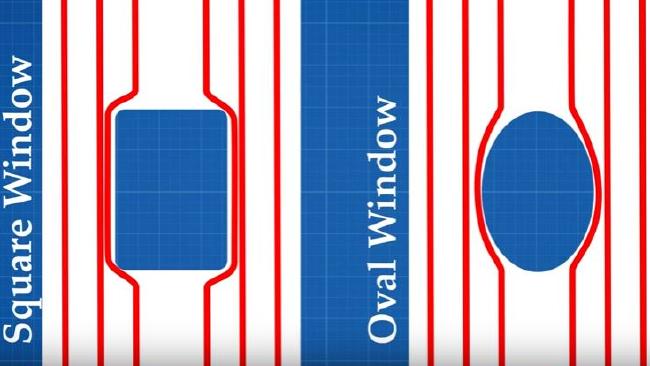
All modern jets have rounded windows, and it has nothing to do with the view.
EVERYTHING inside a plane is carefully designed and tested, and it’s there for a reason.
Brian McManus, a former research and design engineer and current YouTuber, has created a channel called Real Engineering, that provides interesting answers to simple questions.
For example: Why are plane windows round?
As planes became bigger and started carrying more passengers, they started heading higher into the atmosphere to take advantage of the thinner air. Thin air causes less drag, uses less fuel, and less turbulence.
However, those altitudes required a few design changes. First, the cabin had to be pressurised to create a survivable environment. Second, the fuselage had to be cylindrical, to evenly distribute the pressure.
As the plane increases in altitude, the pressure inside the plane gets significantly higher than the pressure outside. The aircraft starts to expand, which puts stress on the walls.
Normally, the stress distributes evenly across the material — but if something interrupts its path, like a window, the stress concentrates.
Planes originally had square windows, but the shape caused pressure to build up in the corners — leading to some horrific accidents.
“The problems caused by cabin pressurisation didn’t develop until the introduction of the first commercial jet powered aircraft, The de Havilland Comet. It entered service in 1952 and initially proved to be a massive success, but just one year into service catastrophe struck. Three Comets suffered fatal mid-flight disintegrations and the entire fleet was grounded until the cause was identified,” McManus wrote on YouTube.

This diagram represents the way stress flows. You can see it concentrates at the corner of the square windows. Picture: Real EngineeringSource:YouTube
When engineers modified the design to include round windows, they found stress flowed more evenly around the edges.
“We often learn the most from our failures, this is particularly true for advancements in the field of engineering. Unfortunately for the engineers in the aviation industry, the prices to pay for failure are high,” McManus wrote.
“The flip-side of this unforgiving industry, is that it consistently provides learning opportunities for engineers, because failure is not an option when peoples lives are at risk.”







